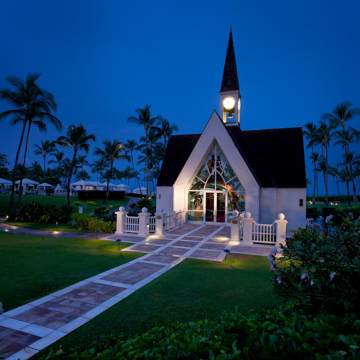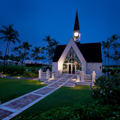The Grand Wailea is a tour de force of embellished opulence taken to a resplendent pinnacle. The nine-story structure defines but is completely subservient to lavishly adorned space. A series of spatial constrictions and releases greets guests as they proceed from the porte-cochere to the open-air atrium with its hipped-roof bar, which forms an island in the middle of the atrium's large water feature. A pair of curvilinear stairs continues the mauka-makai (mountain to ocean) axis, funneling the pedestrian flow which opens up a floor below at the indoor-outdoor dining room. This culminates with a spectacular view of the grounds three stories below. The dining room vista embraces the Pacific's horizon and, more immediately, the formal, royal palm–lined, Mughal-styled waterways and fountains, which cascade downward past the dolphins of sculptor Edward Brownlee to a peaceful repose in one of the resort's many swimming pools.
The main building's spatial procession entwines with a cornucopia of grand gestures, including sculptures, marble-inlaid floors, tropical greenery, and ever-abundant water features, all within an enclosed outdoor environment. A progression of varied spatial experiences, image after image, piles up in an accumulation too overwhelming to be immediately absorbed. The sculpture collection, commendable for its large number of Hawaiian artists, engages the eye throughout the forty-acre complex. Jan Fisher's hula triumvirates greet guests on their journey to the reception desk. Fernando Botero's robust figures, Herb Kane's sylvan contributions, and the large, granite Hawaiian motifs of Sean Browne combine with such works as Yvonne Cheng's mosaic, the dining room murals of Douglas Riseborough, and the paintings of Zhou Ling. The art also includes bronze sculptures by Ferdinand Leger, Pablo Picasso prints, and Andy Warhol silkscreens in the NaPua Gallery.
Ancillary structures located on the grounds also play a character-defining role while accommodating functional requirements. Forms inspired by Japan, Polynesia, and New England commingle with the remainder of the complex without eliciting any jarring contrasts. The clean-lined, contemporary Japanese–styled Kincha Restaurant is tucked into a corner. The restaurant's surrounding pond and Japanese garden, which include eight hundred tons of rock from the base of Mount Fuji, insulate this refined oasis from the more blatant exuberance of much of the complex. Equally exotic and secluded in a far corner beyond the activity pool, with its water slides, water elevator, and rope bridges, are the thatched-roofed, open-air pavilions of the Humuhumunukunukuapuaa Restaurant sitting within a waterfall-fed saltwater lagoon replete with reef fish, an outrigger canoe, and Hawaiian statuary. The restaurant is named for a fish and set in the popular culture of Hawaii, as in the song lyrics, “I wanna go back to my little grass shack in Kealakekua Hawaii, and watch the Humuhumunukunukuapuaa go swimming by.” In 1985 the Hawaii legislature designated it the offcial state fish, based solely on the merit of its euphonic lengthy name.
The clapboard-sided wedding chapel with its fleche surmounting a Greek cross plan also commands its own island. The chapel offers an intimate interior with dark mahogany walls and high vaulted ceilings brilliantly illuminated by four wall-sized Yvonne Cheng stained glass windows depicting ancient Hawaiian scenes. Tucked away in its own corner, the twenty-eight-thousand-square-foot Haleakala Ballroom, with five chandeliers imported from Murano, Italy, opens on a sylvan faux-stone grotto and pool, replete with koi, a bronze mermaid, and a variety of mosses and ferns mingling with orchids and other tropical exotics.
















